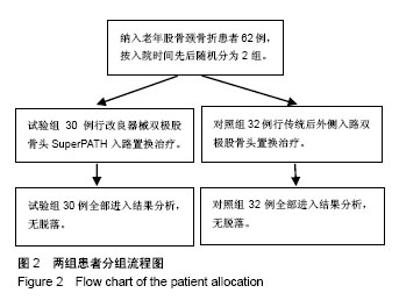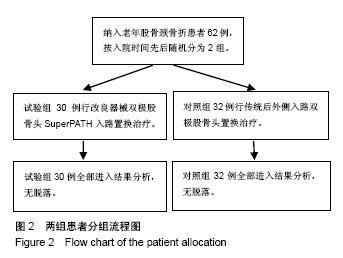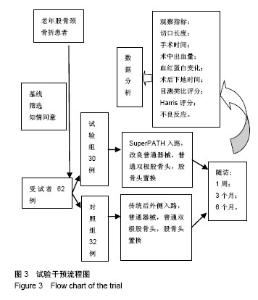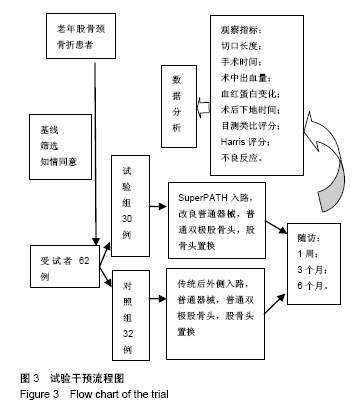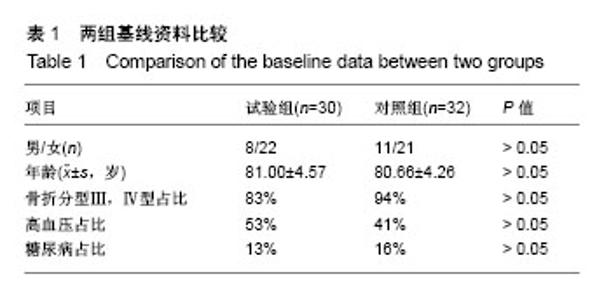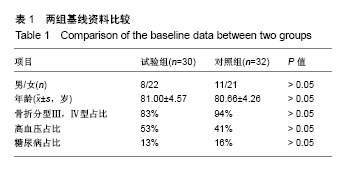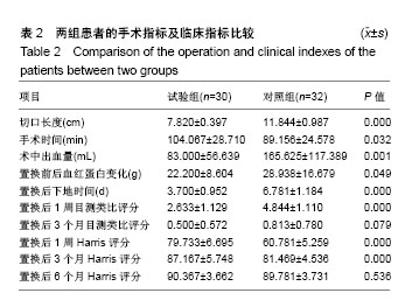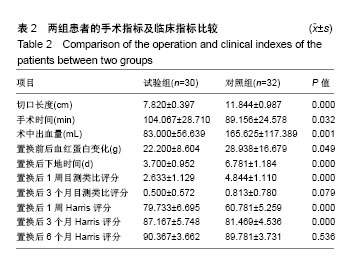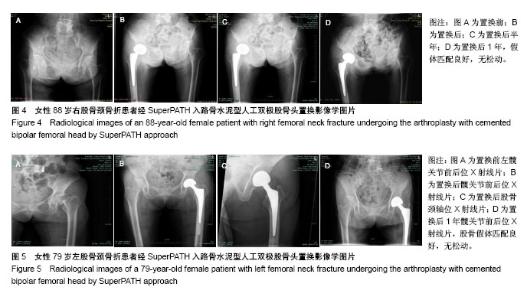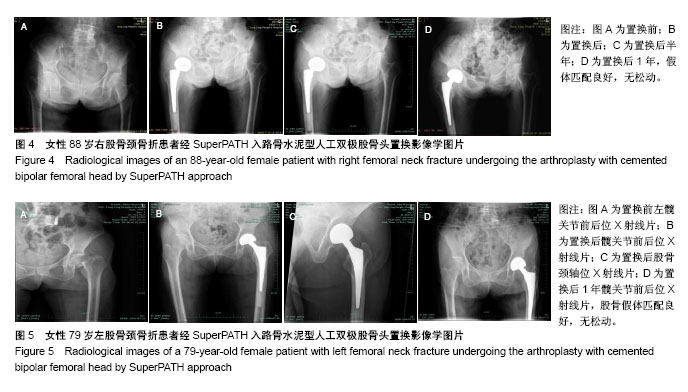| [1] Chow J, Penenberg B, Murphy S. Modified micro-superior percutaneously-assisted total hip: early experiences & case reports. Curr Rev Musculoskelet Med. 2011;4(3):146-150. [2] Murphy SB. Technique of tissue-preserving, minimally- invasive total hip arthroplasty using a superior capsulotomy. Oper Tech Orthop. 2004;14(2): 94-101.[3] Penenberg BL, Bolling WS, Riley M. Percutaneously assisted total hip arthroplasty (PATH): a preliminary report. J Bone Joint Surg Am. 2008;90 (Suppl 4):209-220.[4] 胡方煜,赖仁欢,梁木荣,等.SuperPATH 入路微创人工全髋关节置换术的临床应用[J].微创医学,2016,11(3):416-418. [5] 任东伟,杨革军,赵华磊,等.SuperPATH 切口微创人工全髋关节置换术对股骨头坏死疗效及生活质量的影响[J].河北医科大学学报,2016,37(12):1416-1419.[6] 蒋守海,邱东新,朱信飞.SuperPATH 入路微创全髋关节置换术的初步应用[J].中国骨与关节损伤杂志, 2016,31(12): 1290-1291.[7] Gofton W, Fitch DA. In-hospital cost comparison between the standard lateral and supercapsular percutaneously-assisted total hip surgical techniques for total hip replacement. Int Orthop. 2016;40(3):481-485.[8] Chow J, Fitch DA. In-hospital costs for total hip replacement performed using the supercapsular percutaneously-assisted total hip replacement surgical technique. Int Orthop. 2017; 41(6):1119-1123. [9] Gofton W, Chow J, Olsen KD, et al. Thirty-day readmission rate and discharge status following total hip arthroplasty using the supercapsular percutaneously-assisted total hip surgical technique. Int Orthop. 2015;39(5):847-851.[10] 何启新,乔巨峰,刘永青. SuperPath微创人工全髋关节置换术与常规全髋关节置换术早期疗效比较[J].广东医学院学报, 2016, 34(3):289-292.[11] 佟大可,贺倩芸,刘康,等.SuperPATH 入路髋关节置换术治疗股骨颈骨折的短期疗效评价[J].中国骨与关节损伤杂志, 2017, 32(3):308-310.[12] 侯靖钊,包洪卫,程彦晓.应用 SuperPATH 技术行全髋关节置换的早期疗效观察[J].临床骨科杂志,2017,20(1):50-53.[13] 李金泉,黄青松,徐皓,等.SuperPATH 和后外侧小切口入路 THA治疗股骨头缺血性坏死的近期疗效比较[J].中国骨与关节损伤杂志,2017,32(3):244-247.[14] 袁宏谋,朱佳俊,孙振国,等.SuperPATH入路与后外侧入路行人工全髋关节置换术的疗效比较[J].中国修复重建外科杂志, 2018, 32(1):14-19.[15] Xie J, Zhang H, Wang L, et al.Comparison of supercapsular percutaneously assisted approach total hip versus conventional posterior approach for total hip arthroplasty a prospective, randomized controlled trial.J Orthop Surg Res. 2017;12(1):138.[16] 孙彦平,刘月坤,崔晓亮,等.Superpath全髋置换与全髋置换术的疗效、疼痛程度及髋关节功能分析[J]. 中华骨与关节外科杂志, 2017,10(4):305-307[17] Rasuli KJ, Gofton W. Percutaneously assisted total hip (PATH) and Supercapsular percutaneously assisted total hip (SuperPATH) arthroplasty: learning curves and early outcomes. Ann Transl Med. 2015;3(13):179.[18] Cardenas-Nylander C, Bellotti V, Astarita E, et al. Innovative approach in total hip arthroplasty: supercapsular percutaneously-assisted. Hip Int. 2016;26 Suppl 1:34-37.[19] 吴良浩,禹宝庆,陈帆成.SuperPATH 微创入路人工股骨头置换治疗老年股骨颈骨折:前瞻性、开放性、随机对照临床试验[J].中国组织工程研究,2017,21(7):1009-1014.[20] 梁晓雨,李晓光,薛探.SuperPATH微创伤全髋关节置换术于临床应用中的研究[J].中华肿瘤防治杂志,2016,23(S2):277-278.[21] 黄钢勇,夏军,魏亦兵,等.SuperPATH 入路髋关节置换术治疗高龄老年股骨颈骨折短期临床疗效[J].国际骨科学杂志, 2016, 37(5):331-336.[22] Bodrogi AW, Sciortino R, Fitch DA, et al. Use of the supercapsular percutaneously assisted total hip approach for femoral neck fractures: surgical technique and case series. J Orthop Surg Res. 2016 ;11(1):113.[23] 蔡震海,潘界恩,黄成龙,等. SuperPath 微创与常规全髋关节置换术治疗股骨颈骨折的临床疗效比较研究[J].浙江创伤外科, 2017,22(2):343-345.[24] Della Torre PK, Fitch DA, Chow JC. Supercapsular percutaneously-assisted total hip arthroplasty: radiographic outcomes and surgical technique.Ann Transl Med. 2015; 3(13):180.[25] 颜廷题,田少奇,王远贺,等.SuperPATH 与 Hardinge 入路全髋关节置换术早期临床疗效比较[J].中国修复重建外科杂志, 2017, 31(1):17-24.[26] 曹云,易诚青,李豪青,等. OCM前外侧入路在微创全髋关节置换中的应用[J].中国矫形外科杂志,2018,16(12):888-890.[27] 唐竞,吕明,周一新,等.直接前入路双髋关节同时置换 22 例临床分析.[J].北京大学学报(医学版),2017,49(2):221-225.[28] 彭慧明,钱文伟,翁习生,等.直接前入路微创髋关节置换学习曲线早期病例的短期结果[J].中华骨与关节外科杂志, 2016,9(2): 122-127.[29] 张子琦,王春生,杨佩,等.直接前入路与后入路对人工全髋关节置换术后早期康复的影响比较[J].中国修复重建外科杂志, 2018, 32(3): 329-333.[30] 张洪,马云青. 直接前入路人工全髋关节置换术[J].北京大学学报(医学版),2017,49(2):185-187. |
